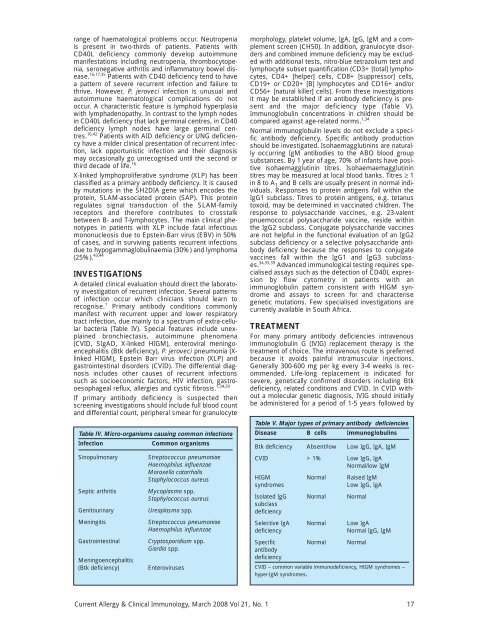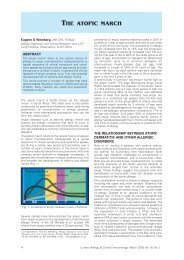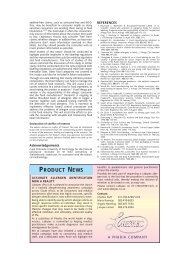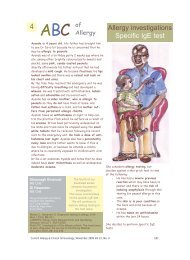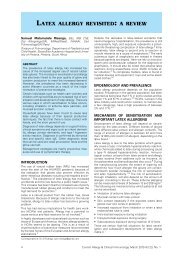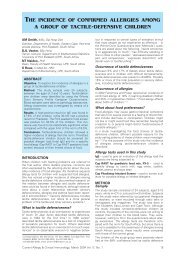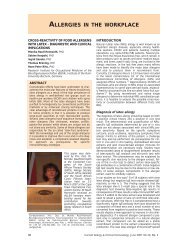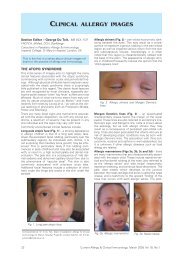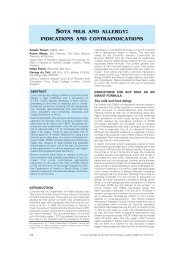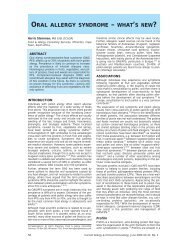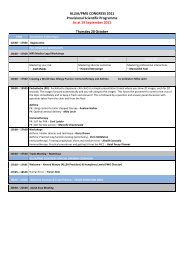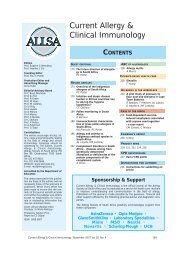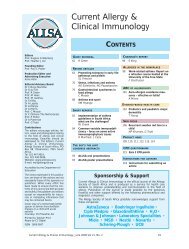ange of haematological problems occur. Neutropeniais present in two-thirds of patients. Patients withCD40L deficiency commonly develop autoimmunemanifestations including neutropenia, thrombocytopenia,seronegative arthritis <strong>and</strong> inflammatory bowel disease.16,17,35 Patients with CD40 deficiency tend to havea pattern of severe recurrent infection <strong>and</strong> failure tothrive. However, P. jeroveci infection is unusual <strong>and</strong>autoimmune haematological complications do notoccur. A characteristic feature is lymphoid hyperplasiawith lymphadenopathy. In contrast to the lymph nodesin CD40L deficiency that lack germinal centres, in CD40deficiency lymph nodes have large germinal centres.16,42 Patients with AID deficiency or UNG deficiencyhave a milder clinical presentation of recurrent infection,lack opportunistic infection <strong>and</strong> their diagnosismay occasionally go unrecognised until the second orthird decade of life. 16X-linked lymphoproliferative syndrome (XLP) has beenclassified as a primary antibody deficiency. It is causedby mutations in the SH2DIA gene which encodes theprotein, SLAM-associated protein (SAP). This proteinregulates signal transduction of the SLAM-familyreceptors <strong>and</strong> therefore contributes to crosstalkbetween B- <strong>and</strong> T-lymphocytes. The main clinical phenotypesin patients with XLP include fatal infectiousmononucleosis due to Epstein-Barr virus (EBV) in 50%of cases, <strong>and</strong> in surviving patients recurrent infectionsdue to hypogammaglobulinaemia (30%) <strong>and</strong> lymphoma(25%). 43,44INVESTIGATIONSA detailed clinical evaluation should direct the laboratoryinvestigation of recurrent infection. Several patternsof infection occur which clinicians should learn torecognise. 1 Primary antibody conditions commonlymanifest with recurrent upper <strong>and</strong> lower respiratorytract infection, due mainly to a spectrum of extra-cellularbacteria (Table IV). Special features include unexplainedbronchiectasis, autoimmune phenomena(CVID, SIgAD, X-linked HIGM), enteroviral meningoencephalitis(Btk deficiency), P. jeroveci pneumonia (XlinkedHIGM), Epstein Barr virus infection (XLP) <strong>and</strong>gastrointestinal disorders (CVID). The differential diagnosisincludes other causes of recurrent infectionssuch as socioeconomic factors, HIV infection, gastrooesophagealreflux, allergies <strong>and</strong> cystic fibrosis. 1,34,39If primary antibody deficiency is suspected thenscreening investigations should include full blood count<strong>and</strong> differential count, peripheral smear for granulocyteTable IV. Micro-organisms causing common infectionsInfectionCommon organismsSinopulmonarySeptic arthritisGenitourinaryMeningitisGastrointestinalMeningoencephalitis(Btk deficiency)Streptococcus pneumoniaeHaemophilus influenzaeMoroxella catarrhalisStaphylococcus aureusMycoplasma spp.Staphylococcus aureusUreaplasma spp.Streptococcus pneumoniaeHaemophilus influenzaeCryptosporidium spp.Giardia spp.Enterovirusesmorphology, platelet volume, IgA, IgG, IgM <strong>and</strong> a complementscreen (CH50). In addition, granulocyte disorders<strong>and</strong> combined immune deficiency may be excludedwith additional tests, nitro-blue tetrazolium test <strong>and</strong>lymphocyte subset quantification (CD3+ [total] lymphocytes,CD4+ [helper] cells, CD8+ [suppressor] cells,CD19+ or CD20+ [B] lymphocytes <strong>and</strong> CD16+ <strong>and</strong>/orCD56+ [natural killer] cells). From these investigationsit may be established if an antibody deficiency is present<strong>and</strong> the major deficiency type (Table V).Immunoglobulin concentrations in children should becompared against age-related norms. 1,34Normal immunoglobulin levels do not exclude a specificantibody deficiency. Specific antibody productionshould be investigated. Isohaemagglutinins are naturallyoccurring IgM antibodies to the ABO blood groupsubstances. By 1 year of age, 70% of infants have positiveisohaemagglutinin titres. Isohaemaemagglutinintitres may be measured at local blood banks. Titres ≥ 1in 8 to A 1 <strong>and</strong> B cells are usually present in normal individuals.Responses to protein antigens fall within theIgG1 subclass. Titres to protein antigens, e.g. tetanustoxoid, may be determined in vaccinated children. Theresponse to polysaccharide vaccines, e.g. 23-valentpnuemococcal polysaccharide vaccine, reside withinthe IgG2 subclass. Conjugate polysaccharide vaccinesare not helpful in the functional evaluation of an IgG2subclass deficiency or a selective polysaccharide antibodydeficiency because the responses to conjugatevaccines fall within the IgG1 <strong>and</strong> IgG3 subclasses.34,35,39 Advanced immunological testing requires specialisedassays such as the detection of CD40L expressionby flow cytometry in patients with animmunoglobulin pattern consistent with HIGM syndrome<strong>and</strong> assays to screen for <strong>and</strong> characterisegenetic mutations. Few specialised investigations arecurrently available in South Africa.TREATMENTFor many primary antibody deficiencies intravenousimmunoglobulin G (IVIG) replacement therapy is thetreatment of choice. The intravenous route is preferredbecause it avoids painful intramuscular injections.Generally 300-600 mg per kg every 3-4 weeks is recommended.Life-long replacement is indicated forsevere, genetically confirmed disorders including Btkdeficiency, related conditions <strong>and</strong> CVID. In CVID withouta molecular genetic diagnosis, IVIG should initiallybe administered for a period of 1-5 years followed byTable V. Major types of primary antibody deficienciesDisease B cells ImmunoglobulinsBtk deficiency Absent/low Low IgG, IgA, IgMCVID > 1% Low IgG, IgANormal/low IgMHIGM Normal Raised IgMsyndromesLow IgG, IgAIsolated IgG Normal NormalsubclassdeficiencySelective IgA Normal Low IgAdeficiencyNormal IgG, IgMSpecific Normal NormalantibodydeficiencyCVID – common variable immunodeficiency, HIGM syndromes –hyper-IgM syndromes.<strong>Current</strong> <strong>Allergy</strong> & <strong>Clinical</strong> <strong>Immunology</strong>, <strong>March</strong> <strong>2008</strong> Vol 21, No. 1 17
e-evaluation of serum immunoglobulin concentrationssince hypogammaglobulinaemia may be transient <strong>and</strong>resolve spontaneously. 45,46IVIG is not indicated in IgA deficiency. In patients withIgA deficiency, transient hypogammaglobulinaemia ofinfancy or isolated IgG subclass deficiency plus recurrentinfections, prophylactic antibiotics may be administered,using amoxicillin (twice daily) or azithromycin(weekly). In transient hypogammaglobulinaemia ofinfancy IVIG replacement may be used in children withsevere, recurrent infections until immunoglobulin productionnormalises. Patients with isolated IgG subclassdeficiencies account for the greatest misuse of IVIG.Immunoglobulin therapy should be used for a minorityof patients who are unable to produce specific antibody<strong>and</strong> continue to experience recurrent infectionsdespite prophylactic antibiotics. 35,39,40The treatment of HIGM syndromes includes theadministration of IVIG. In patients with X-linked HIGM,IVIG does not prevent the development of sclerosingcholangitis <strong>and</strong> malignancy. 17 Alternative therapieshave been employed successfully including granulocyte-colony-stimulatingfactor for neutropenia, allogenicbone marrow transplantation (BMT) or cord blood celltransplantation to cure X-linked HIGM, <strong>and</strong> combinedBMT <strong>and</strong> liver transplantation to addressX-linked HIGM complicated by end-stage liver failure.17,47-50 Similarly, X-linked lymphoproliferative syndromehas been treated with IVIG <strong>and</strong> BMT. 43OUTCOMEInadequate diagnosis or suboptimal treatment placesthe patient at risk of recurrent infections, organ-specificcomplications <strong>and</strong> early mortality. Recurrent respiratoryinfections may lead to bronchiectasis <strong>and</strong> end-stagelung disease with cor pulmonale <strong>and</strong> respiratory failure.Abnormal lung functions, usually an obstructive pattern,have been reported to be more common in CVIDthan in Btk deficiency. Lung functions should be monitoredregularly to ensure that IVIG replacement is optimisedto prevent these complications. 3,40Gastrointestinal disorders occur in 20-47% of patientswith primary antibody deficiencies. 3 Hepatic complicationsmay occur as a result of specific viral infectionssuch as hepatitis C <strong>and</strong> primary biliary cirrhosis, oftenassociated with Cryptosporidium parvum infection. InX-linked HIGM this invariably leads to end-stage liverfailure. 50 Primary antibody deficiencies are associatedwith an increased risk for malignancy, varying from 1.8-to 13-fold. Lymphoreticular malignancies, particularlynon-Hodgkin's lymphomas are most frequent. Othercomplications include disability arising from meningitis,neurodegeneration <strong>and</strong> autoimmune phenomena. 3,40Despite these problems many well-managed patientsrespond to appropriate treatment resulting in improvedlife expectancy <strong>and</strong> decreased infectious complications.In conclusion, many primary antibody deficiencies havebeen comprehensively characterised. The increasedknowledge has impacted favourably on treatment <strong>and</strong>long-term prognosis.Declaration of conflict of interestThe author declares no conflict of interest.REFERENCES1. De Vries E, for the <strong>Clinical</strong> Working Party of the European Societyfor Immunodeficiencies (ESID). Patient-centred screening for primaryimmunodeficiency: a multi-stage diagnostic protocol for nonimmunologists.Clin Exp Immunol 2006; 145: 204-214.2. Maródi L, Notarangelo LD. Immunological <strong>and</strong> genetic bases ofnew primary immunodeficiencies. Nat Rev Immunol 2007; 7: 851-861.3. Wood P, Stanworth S, Burton J, et al. Recognition, clinical diagnosis<strong>and</strong> management of patients with primary antibody deficiencies:a systematic review. Clin Exp Immunol 2007; 149; 410-423.4. Stiehm RE. The four most common pediatric immunodeficiencies.Adv Exp Med Biol 2007; 601: 15-26.5. Fischer A, Malissen B. Natural <strong>and</strong> engineered disorders of lymphocytedevelopment. Science 1998; 280: 237-243.6. Cunningham-Rundles C, Ponda PP. Molecular defects in T- <strong>and</strong> B-cell primary immunodeficiency diseases. Nat Rev Immunol 2005;5: 880-892.7. Geha RS, Notarangelo LD, Casanova J, et al. Workshp summary.Primary immunodeficiency diseases: an update from theInternational Union of Immunological Societies Primary ImmunodeficiencyDiseases Classification Committee. J <strong>Allergy</strong> ClinImmunol 2007; 120: 776-794.8. Bruton OC. Agammaglobulinaemia. Pediatrics 1952; 9: 722-728.9. Vetrie D, Vorechovsky I, Sideras P, et al. The gene involved in X-linked agammaglobulinaemia is a member of the src family of protein-tyrosinekinases. Nature 1993; 361: 226-233.10. Conley ME, Broides A, Hern<strong>and</strong>ez-Trujillo V, et al. Genetic analysisof patients with defects in early B-cell development. Immunol Rev2005; 203: 216-234.11. Pienaar S, Eley B, Beatty D, Henderson HE. X-linked agammaglobulinaemia<strong>and</strong> the underlying genetics in two kindreds. J PaediatrChild Health 2000; 36: 453-456.12. Conley ME. Early defects in B cell development. Curr Opin <strong>Allergy</strong>Clin Immunol 2002; 2: 517-522.13. Ferrari S, Lougaris V, Caraffi S, et al. Mutations of the Igbeta genecause agammaglobulinemia in man. J Exp Med 2007; 204: 2047-2051.14. Dobbs AK, Yang T, Farmer D, Kager L, Parolini O, Conley ME.Cutting edge: a hypomorphic mutation in Igbeta (CD79b) in apatient with immunodeficiency <strong>and</strong> a leaky defect in B cell development.J Immunol 2007; 179: 2055-2059.15. Minegishi Y, Rohrer J, Coustan-Smith E, et al. An essential role forBLNK in human B cell development. Science 1999; 286: 1954-1957.16. Etzioni A, Ochs HD. The hyper-IgM syndrome – an evolving story.Pediatr Res 2004; 56: 519-525.17. Levy J, Espanol-Boren T, Thomas C, et al. <strong>Clinical</strong> spectrum of X-linked hyper-IgM syndrome. J Pediatr 1997; 131: 47-54.18. Pienaar S, Eley BS, Hughes J, Henderson HE. X-linked hyper IgM(HIGM1) in an African kindred: the first report from South Africa.BMC Pediatr 2003; 3: 12. http//:www.biomedcentral.com/1471-2431/3/12.19. Jain A, Ma CA, Liu S, Brown M, Cohen J, Strober W. Specific missensemutations in NEMO result in hyper-IgM syndrome withhypohydrotic ectodermal dysplasia. Nat Immunol 2001; 2: 223-228.20. Salzar U, Grimbacher B. Update on common variable immunodeficiency(CVID). ESID Newsletter 2004; 3: 17-23.21. Cunningham-Rundles C, Bodian C. Common variable immunodeficiency:clinical <strong>and</strong> immunological features of 284 patients. ClinImmunol 1999; 92: 34-48.22. European Society for Immunodeficiency. Diagnostic criteria forPID. http//:www.esid.org (last accessed: 14 November 2007.)23. Weston SA, Prasad ML, Mulligghan CG, Chapel H, Benson EM.Assessment of male CVID patients for mutations in the Btk gene:how many have been misdiagnosed? Clin Exp Immunol 2001; 124:465-469.24. Eastwood D, Gilmour KC, Nistala K, et al. Prevalence of SAP genedefects in male patients diagnosed with common variable immunodeficiency.Clin Exp Immunol 2004; 137: 584-588.25. Grimbacher B, Hutloff A, Schlesier M, et al. Homozygous loss ofICOS is associated with adult-onset common variable immunodeficiency.Nat Immunol 2003; 4: 261-268.26. Van Zelm MC, Reisli I, van der Burg M, et al. An antibody-deficiencysyndrome due to mutations in the CD19 gene. N Engl J Med2006; 354: 1901-1912.27. Salzar U, Chapel HM, Webster ADB, et al. Mutations inTNFRSF13B encoding TACI are associated with common variableimmunodeficiency in humans. Nat Genet 2005; 37: 820-828.28. Castigli E, Wilson SA, Garibyan L, et al. TACI is mutant in commonvariable immunodeficiency <strong>and</strong> IgA deficiency. Nat Genet 2005; 37:829-834.29. Sekine H, Ferreira RC, Pan-Hammarström Q, et al. Role for Msh5in the regulation of Ig class switch recombination. Proc Natl AcadSci USA 2007; 104: 7193-7198.18 <strong>Current</strong> <strong>Allergy</strong> & <strong>Clinical</strong> <strong>Immunology</strong>, <strong>March</strong> <strong>2008</strong> Vol 21, No. 1


